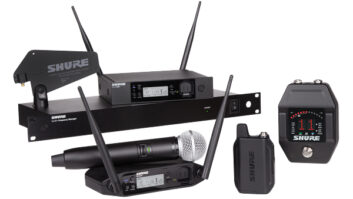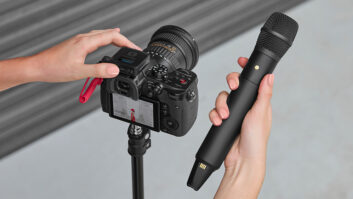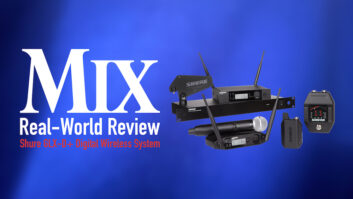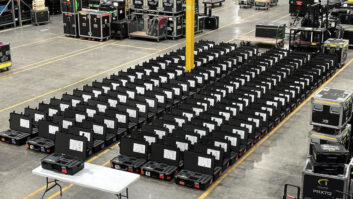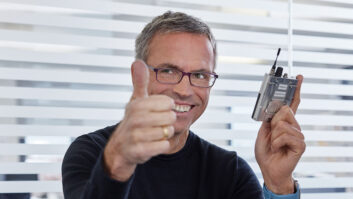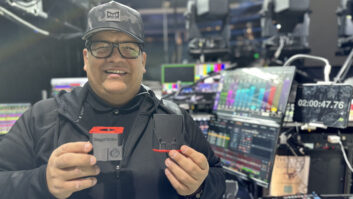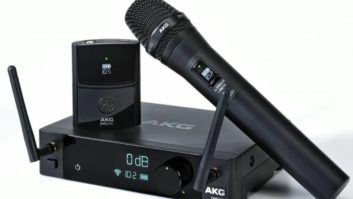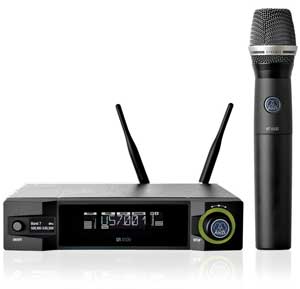
To say that 2009 has been an challenging year in the wireless audio industry is truly an understatement. Yet, it’s barely a month after June 12, the second FCC deadline for the changeover to DTV (and the elimination of the legal availability of the 698 to 806MHz bandwidth to audio users) and the sky didn’t fall. For most pro wireless owners, that day came and went without incident. In fact, for a while, the 700MHz wireless band is probably pretty clear, although transmitting using those frequencies is certainly a bad idea, as it’s now illegal, and at some point that particular spectrum is going to get very crowded, very quickly.
For those holdout owners of 700MHz gear who haven’t made the conversion to legal operation, many pro wireless manufacturers — including AKG, Audio-Technica, Lectrosonics, Sennheiser, Shure and Sony — all offer rebate programs for existing equipment, while most companies will work with customers to update units that can be modified/updated to operate on different frequencies. In researching what’s new in handheld wireless systems, we found that many companies — among them Audio-Technica, Electro-Voice, Lectrosonics, Shure and Sony — have kept their flagship offerings unchanged, although perhaps with different channel blocks.
he AKG WMS 4500 is available in two new frequency selections: Band 7 (500 to 530 MHz) and Band 8 (570 to 600 MHz).
That said, this is a great time to invest in wireless systems for many reasons. For the most part, the FCC reallocation dust has finally settled. Although the skies are somewhat more crowded than before, a wide range of frequencies are available, from the usual UHF bands to 2.4GHz (Sabine Smart Spectrum) and even 6.350 GHz, as used in Audio-Technica’s SpectraPulse UWB systems. Digital wireless units are beginning to emerge, although analog systems carry a lion’s share of the market. With a variety of online tools and programs for frequency coordination and system control, multisystem operation is less complicated and straightforward, with fewer onsite “surprises.”
Listed alphabetically, here’s an overview of what’s new in handheld wireless systems, although all systems mentioned here are also available with bodypack transmitters. And if you needed another reason to check out a new wireless system, today’s units are simply better, more reliable and rugged than ever before.
AKG
AKG’s (www.akg.com) latest DMS 700 digital wireless microphone system provides features such as digital audio encryption, infrared transmitter/receiver link for quick setups, onboard DSP (low-cut filter, 3-band EQ, dbx compression/limiting) and HiQnet networking with other Harman products. The single-rackspace receiver has two frequency bands, each offering a tuning range of up to 155 MHz (within the 548.1 to 697.9MHz band) for up to 100 simultaneous channels.
Two versions of the 50mW RF output DHT 700 handheld transmitter are offered: one with AKG D5 supercardioid dynamic capsule and one with a C5 cardioid condenser capsule. Integral to the system is a fast DC Pulse Technology charger that quickly charges the rechargeable batteries inside the transmitter for up to eight hours of operation.
AKG’s top-end WMS 4500 analog wireless is now available in two new frequency selections: Band 7 (500 to 530 MHz) and Band 8 (570 to 600 MHz), allowing more options for multichannel systems in crowded RF environments. HiQnet™ operation is possible via the optional HUB 4000 Q, and with the System Architect™ software the WMS 4500 can be configured and monitored remotely from a PC.
The WMS 4500 system’s SR 4500 receiver has onboard AutoSetup settings for intermodulation-free channel selection; EnvironmentScan settings for RF range scanning; and a Rehearsal mode for saving system data during rehearsal setups. The PT 4500 handheld emitter was redesigned to include a new battery casing for easier access. The mic accommodates interchangeable AKG capsule modules, including D5, D7, D3700, D3800, C5900, C5 and C535 EB.
beyerdynamic
Slated to begin shipping last month, the new Opus 600 wireless from beyerdynamic (www.beyerdynamic-usa.com) offers up to 12 channels per frequency range, interchangeable capsules for its handheld units (including the TG-X 60 capsule in the DM 960 mic head) and more than 20 hours of operation from two AA alkaline batteries. The receiver displays AF and RF levels, and the transmitters have a low-battery warning display. For quick setups, an AutoScan function enables automatic search for interference-free frequencies, with fast, easy infrared transmission of the frequencies to the transmitter.
Line 6
Line 6 (www.line6.com) is now shipping its X2™ XDR955 handheld mic system ($859.99 retail) with a single-rackspace receiver. The diversity system uses Line 6 digital audio transmission (24-bit delta sigma, 128x oversampled conversion) with a 10 to 20k Hz bandwidth and up to five units operating in the 902 to 928MHz band at 15 mW for a range of up to 300 feet. Dual-RF anti-jam technology lets the XDR955 broadcast dual signals to four receivers that work simultaneously to avoid dropouts. Plus, the system’s proprietary digital data stream only recognizes signals embedded with a unique digital signature. The cardioid X2 XDH4 handheld can run up to eight hours on two AA batteries.
Mipro
Based on Mipro’s (www.mipro.com.tw) ACT Series, the single-channel ACT- 51 and dual-channel ACT-52 have the same high reliability and diversity UHF (620 MHz to 950 MHz — depending on country), but add two additional functions: a full-color VFD receiver panel, and the ability to set up and view all functions on that same VFD screen. The ACT-51/52 also incorporate AutoScan to locate clear frequencies and Automatic Channel Targeting that automatically syncs the receiver and transmitter with a button-push. The ACT-7H handheld transmitter works for up to 18 hours on two AA batteries, and can be fitted with condenser cardioid or dynamic hypercardioid capsules.
Nady Systems
The W-1KU from Nady (www.nady.com) offers 1,000 user-switchable UHF frequencies per band and a backlit front panel LCD that indicates selected audio output volume level, RF signal strength, group, channel and A/B Diversity antenna status. Sophisticated IF filtering allows simultaneous operation of multiple W-1KU systems in the same location. The all-metal HT-1KU handheld unit offers full-menu backlit LCDs, and channels can be switched manually with up/down buttons on the transmitter or via ASC™ (Auto-Select Channels) IR download of selected channel for synchronization with receiver.
Sabine
Now shipping, Sabine’s (www.sabine.com) new Smart Spectrum SWM6000 wireless operates in the 902 to 928MHz ISM band, continuing the tradition of the company’s SWM7000 systems, which operate in the 2.4GHz ISM band. Like the SWM7000, the SWM6000 systems offer built-in RF scanning and recording, and remote control via third-party controllers such as Crestron or AMX. SWM6000 Series receivers are available in single- and 2-channel models, and feature onboard digital channel-strip processing, FBX Feedback Exterminator, compressor/limiter, adaptive de-esser, parametric filters and Mic SuperModeling™ for a virtual cabinet of mic sounds.
The SW60 handheld transmitters for the SWM6000 Series are available with Audix OM3 or OM5 dynamic capsules, or a Voice Technologies condenser element. Operation is via Sabine NiMH rechargeable packs (for up to eight hours) or two alkaline AA cells for 14 hours of run time.
Samson
Samson (www.samsontech.com) expands its AirLine Series with the AirLine Synth, a true-diversity system retailing at $689.99 that can operate up to 11 simultaneous systems on more than 300 frequencies. The AirLine Synth AR300 receiver can be rackmounted with up to four receivers in a rackspace, and its LED front panel shows AF/RF levels, frequency, audio output level and channel mix setting. Other features include automatic scanning and infrared programming, balanced and unbalanced outputs, and front- or rear-mountable antennae. Samson is also now shipping the AR4300 AirLine Synth Quad module, which holds up to four AR300M receivers in a single rackspace and adds touches such as built-in antenna distribution, headphone cue system for monitoring each channel (or a mix of all four), and individual channel XLR and TRS outputs, as well as mixed XLR and TRS outs.
The handheld AirLine Synth system comes with a Samson Q7 dynamic mic and the AX300 plug-on transmitter unit, which can connect to any pro dynamic microphone. The AX300 has an onboard digital channel display, low-battery indicator and Mute switch, and it operates for up to 10 hours on two AA batteries.
Sennheiser
Now available in the U.S. is the third generation of Sennheiser’s (www.sennheiserusa.com) evolution G3 wireless, with three new 100, 300 and 500 Series true-diversity receivers, all with 1,680 tunable UHF frequencies and a one-touch sync feature enabling G3 transmitters and receivers to link via an infrared interface. The top-end 500 and 300 Series receivers offer built-in Ethernet support for connecting to a PC running Sennheiser’s Wireless System Manager software, and the 300/500 units can reduce power from 30 mW to 10 mW to accommodate more channels in a given frequency range.
Three handhelds are available for each of the new G3 Series. For the 500 Series, users can choose from models with Sennheiser’s e965 cardioid/supercardioid (switchable) condenser or the dynamic e945 supercardioid or e935 cardioid capsules. Series 100 and 300 owners can choose from transmitters with the e865 supercardioid condenser or dynamic e835 cardioid or e845 supercardioid elements. And all handheld transmitters can now be powered by rechargeable battery packs instead of standard batteries, and have external charging contacts for recharging the battery pack while still in the transmitter.
Unveiled at NAB 2009 was Sennheiser’s 2000 Series professional, entry-level wireless system. The system is offered with a choice of receivers including the rackmount EM 2000 single-channel and EM 2050 2-channel — both dual-diversity units with onboard equalization, up to 3,000 operating frequencies, integrated antenna splitting for daisy-chaining up to eight receivers, Ethernet port for PC control using Wireless Systems Manager software and data interfacing to the transmitters using an infrared link.
The SKM 2000 handheld transmitter features switchable transmission power, intuitive menu navigation and external contacts for charging the batteries directly. The handheld is also compatible with all EW Series capsules, including the new MMK 965-1 (e965) condenser, which launches this month.
TOA/Trantec
The latest pro wireless from TOA (www.toaelectronics.com), the Trantec S5.5 Series is designed by BBM Electronics Group Ltd., a wholly owned subsidiary of TOA Corp. The multichannel UHF S5.5 system can accommodate up to 35 simultaneous channels and features simple transmitter/receiver programming over an infrared link and remote PC performance monitoring, setup and control through a USB 2 port. The hypercardioid dynamic transmitter operates for more than 10 hours on a single AA battery, and has an LCD screen showing frequency, mic sensitivity adjustment and battery status.
Zaxcom
Zaxcom (www.zaxcom.com) has upgraded all of its wireless transmitters — including the TRX 800 handheld — to ship with adjustable output power settings of 10/25/50 mW. The TRX 800 operates in the 518 to 870MHz UHF range and offers 5-hour run time on a CR123 battery. It has an interchangeable screw-on capsule that’s compatible with Shure wireless elements. However, its most notable feature is an internal recording option that simultaneously stores up to 12 hours of audio on removeable miniSD Flash media for protection when dropouts cannot be tolerated.
George Petersen is the executive editor of Mix.
WHAT’S OLD IS NEW AGAIN
Interchangeable Mic Capsules
Maybe you’re looking for a new sound or simply want more variation from that handheld wireless you’re considering. And the fastest, easiest way to new sounds is in the form of replacement capsules with either a different tone or an alternate pickup pattern that better suits the style and voicing of any singer. If you’re interested, the best place to start is by contacting your system’s manufacturer, as AKG, beyerdynamic, Mipro, Shure, Sabine and Sennheiser are among those providing capsule alternatives. And don’t forget third-party sources. Neumann, for example, makes the KK 104/105S capsule modules for Sennheiser’s SKM 5200/SKM 5000N Series based on its KMS 105/140/150 family of wired vocal mics.
In terms of selection, Shure takes the prize with eight optional capsule offerings (SM58, SM86, SM87A, Beta 58, Beta 87A, Beta 87C, KSM9/SL and KSM9/BK) for its UHF-R Series UR2 handheld transmitters. Five are available for Shure’s SLX2 (SM58, SM86, Beta 58, Beta 87A and Beta 87C), with those same five (plus an SM87A capsule) for the ULX2 handhelds. Need more choices? Heil Sound (www.heilsound.com) has begun shipping two cardioid dynamic capsule modules that fit Shure screw-on transmitter bodies. Finished in basic black, the Heil RC-35 ($235) uses the same 1.5-inch cardioid element as its PR-35 wired mic; the $198 RC-22 takes the capsule from Heil’s PR-22 mic, and as a bonus includes silver, gold and black grilles.
